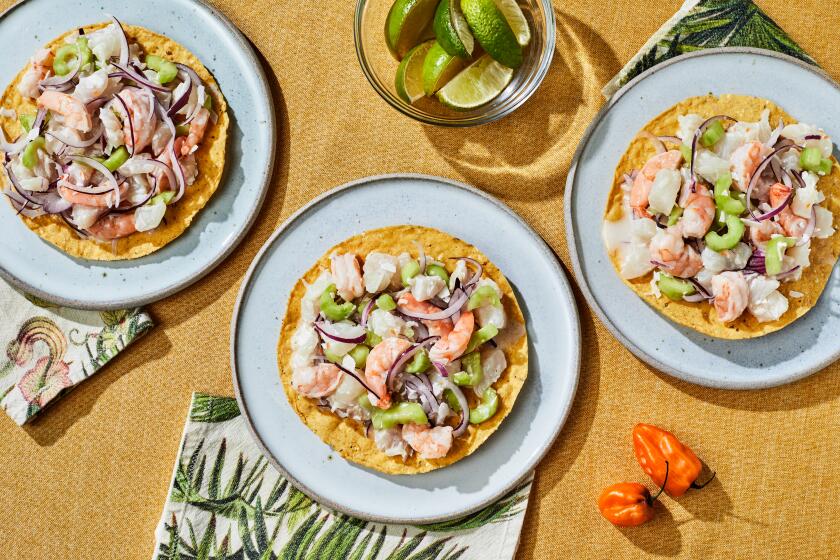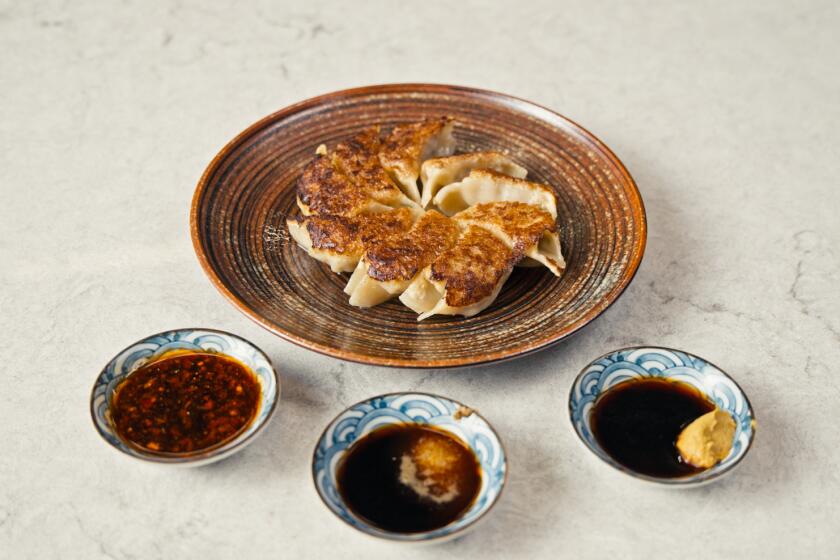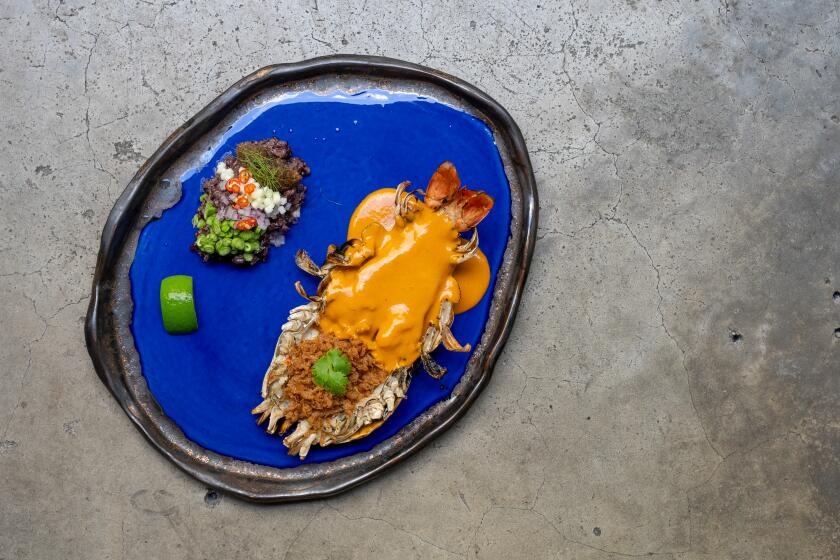Chicken faux gras

PRESERVED lemons in half an hour. A new, smarter way to peel and seed a tomato. An inexpensive, easy-to-make chicken liver mousse with a flavor reminiscent of foie gras -- complete with a beautiful aspic. A foolproof method for making spectacular rack of lamb so tender you can cut it with a fork.
A cook’s holiday wish list?
Perhaps. Yet in this cookbook publishing season such wishes are coming true.
The ideas in this fall’s best books are so smart and well-explained you’d think they come from seasoned cookbook writers, those indefatigable stalwarts of food publishing who test and retest, always with the home cook in mind, and publish the volumes we actually open and cook from and stain and shelf at eye level.
No, this time around the great ideas are from the chefs.
Chef cookbooks are big this year, with new tomes out from Michael Mina, Daniel Boulud, Marcus Samuelsson, Michel Richard, Francois Payard, Jamie Oliver and more. Most of them offer what we all expect in a chef’s cookbook -- eye candy. As a group, they’re beautiful objects, gorgeously photographed, books you want to have out on your coffee table. It’s a good crop.
But three books stand out. Original, intelligent and well-executed, they won’t stay on that coffee table for long.
Samuelsson’s “The Soul of a New Cuisine: A Discovery of the Foods and Flavors of Africa” represents a personal culinary odyssey. Raised in Sweden by adoptive parents, Samuelsson returned for his second book to the country of his birth, Ethiopia, and in the process toured the entire continent, a journey we see through Gediyon Kifle’s sweeping photographs of Africa’s food, landscape and people. It was a risky conceit for a French-trained chef known for his gravlax, not his doro watt. But the result is a compelling blend of traditional recipes and a kind of personal fusion food.
Like gravlax, Samuelsson’s yellowtail is cured in a sugar and salt mixture to which he adds a hefty dose of the spice blend ras al-hanout, pairing it with preserved citrus peel, to brilliant effect -- the fish has a rich, silky interior with a subtle flavor that plays off the dense spice of a lightly seared crust. Normally, preserved citrus takes weeks to cure, but Samuelsson gets a similar effect by triple-blanching the peels, then simmering them -- for just five minutes -- in juice, salt, honey, ginger and spices.
Other dishes are just as inspired: grilled skewers of duck breast, red onions, peppers and pears; shrimp marinated in piri piri, a fiery sauce from Mozambique, then sauteed and wrapped in lettuce leaves.
“Michael Mina: The Cookbook” seems, at first glance, to be much more in line with what you’d expect of a chef book. The recipes in this debut book are elaborate and inventive, organized around the “trio” concept Mina employs in his restaurants, including Stonehill Tavern, which he opened in February in the St. Regis Resort Monarch Beach at Dana Point. The idea is a clever one: Take a central dish, a fish or meat usually (or with desserts, a cake or a sorbet) and create a matrix of components that can be paired with it. Each trio can be served together, like a mini-tasting menu, or you can make only one, or mix and match.
Some are far too complicated for most home cooks; more than half require expensive, difficult-to-find ingredients such as Kobe beef, truffles and fresh abalone. Mina’s recipe for torchon of foie gras, for example, is particularly daunting: The cold version calls for any of three fruit consommes, gastriques and gelees, in addition to making the torchon itself, a two-day experience.
But when this book is on target, it rocks.
Mina’s olive oil-poached lamb trio is sublime, not just in the lamb’s buttery texture and the flavors that complement it, but also in the simple brilliance of the technique. The racks are slowly poached in 135- to 140-degree oil. Amazingly, you can poach it anywhere from an hour to a few -- as long as the oil doesn’t rise above 140 degrees. When you’re ready to serve, just sear it, plate it with the accompaniments and bring it to the table. It’s an amazing holiday dish you can mostly make ahead.
The book isn’t perfect -- the recipe, as printed, calls for poaching the lamb for 25 minutes to an hour or more. But at 25 minutes -- and even 45 minutes -- the meat was far too rare. Poached for an hour, however, and even for more than two, the rack was a perfect medium-rare, delicate and velvety. Paired with harissa-spiked ratatouille, potatoes poached in more olive oil, and a rosemary gremolata -- the best of the three trios offered -- the whole thing is labor intensive, but well worth the effort.
Blissful, indeed
THE standout book of the season, though, is Michel Richard’s “Happy in the Kitchen.” The book is just that -- a happy, exuberant cookbook as remarkable for its great ideas as its joie de vivre. Deborah Jones’ photographs, stunning as the dishes themselves, highlight Richard’s techniques.
Richard’s book, his second after a long hiatus (his first, “Home Cooking With a French Accent,” was published in 1993) offers one revelation after another. Thin strips of cuttlefish become a fascinating take on fettuccine, the opaque “noodles” paired with a sauce of crabmeat and corn. In another take on some of the same ingredients, crab cakes are encased in fresh corn bound with pureed shrimp. The cakes were astonishing, the faint hint of shrimp added a depth of flavor as well as binding the corn.
Richard’s “chicken faux gras” is a deceptively simple chicken liver mousse -- just raw chicken livers pureed with onions and garlic cooked in butter and cream, then strained into ramekins and poached, and finally topped with a cucumber and parsley gelee. Spread on a baguette, the stuff tastes remarkably like foie gras, buttery and smoothly subtle.
And then there’s that fabulous tomato trick: The step-by-step photographs deftly show how to blanch, then core the tomatoes, remove the seedy interior in one turn of the knife, and unroll the usable part of the tomato in one long strip. A tedious kitchen chore has never looked so appealing.
In “Braise: A Journey Through International Cuisine,” Daniel Boulud’s explorations aren’t as personal as Samuelsson’s, nor as inventive as Mina’s or Richard’s. But it’s a pleasure to have a chef of Boulud’s caliber offer a book devoted to the simple, rustic technique of the braise. These are deeply flavored, homey creations that encompass a wide range of flavor profiles -- such as oxtails with Asian spices. Merguez sausages top a braise of spinach and white beans, with heat provided by four-spice powder and a healthy dose of harissa. Both dishes showcase wonderful layers of flavor, though each had problems of texture, with fragile vegetables breaking down too quickly. Chicken basquaise with artichokes was overpowered by heat: two teaspoons of piment d’Espelette and a whole teaspoon of crushed red pepper flakes. A dessert of braised apricots with clafouti, however, was fabulous.
“One Spice, Two Spice,” by Floyd Cardoz, chef at New York’s Tabla, gets the spices just right, but the recipes are often problematic. His tuna tartare with apples is a striking take on an often predictable dish, paired with radishes, peanuts and spices. Other recipes don’t fare as well, suffering from vague directions or even (in the case of a fennel salad that wound up with a texture like a potato salad) perhaps missing components.
Francois Payard, a former pastry chef at Boulud’s Restaurant Daniel who went on to open his own eponymous restaurant in Manhattan, gives us “Bite Size: Elegant Recipes for Entertaining.” But think twice before you plan a holiday cocktail party around this one: Of the three recipes tested, one didn’t work at all (a prettily photographed vegetable terrine cut into bite-sized pieces) -- the three eggs called for weren’t nearly enough to cover the layers of grilled vegetables. Another, a kind of vitello tonnato bruschetta, was good, but not nearly good enough for the work involved. And a third, a pea puree with ricotta salata in tiny filo cups, fell completely flat, and it was way too much work for a yield of 20 tiny bites.
Italian flavor
THREE new books focus on Italian cooking.
Jamie Oliver’s “Jamie’s Italy,” the British “naked chef’s” sixth, is a jaunty, chummy book. Here and in Britain, he tells us, “we tend not to eat enough veg”; Italy’s different, though. “So listen up,” he writes. “Let’s be like them and big up the greens.”
It’s charming enough to make us want to follow him as he cooks up an antipasto of simply dressed greens.
Oliver offers lots of compelling recipes -- and an occasional dud. His caponata is fairly classic, quick and easy. Pork chops stuffed with prosciutto-sage butter are seared in a pan, then dropped onto diced potatoes and matchstick pancetta that have been roasting in the oven. The instructions feel incomplete -- shouldn’t I stir that now and then? -- but the thing turns out delicious. Amalfi baked lemons, on the other hand, are a terrible waste of buffalo mozzarella.
New York City chef Michael White gives us a mixed bag in “Fiamma.” A chicken soup with escarole and cheese dumplings is deliciously simple and rustic, and easy to prepare. Baked polenta with broccoli rabe and pancetta sounds great, but the polenta winds up tough rather than crisp.
From Maestro in Washington, D.C., chef Fabio Trabocchi’s “Cucina of Le Marche,” meanwhile, is hardbound trouble. Branzino in salsa piccante suffers an assault by olive oil -- one and a half cups go into the dish of two fish, meant to serve six.
Worse yet is Trabocchi’s recipe for ravioli with fresh herbs and greens in lemon butter. It starts with a double recipe of one of the two pasta dough recipes in the book, each of which call for 16 to 18 egg yolks. With my KitchenAid mixer fitted with a dough hook on slow as instructed, I added the yolks (mixed with milk, olive oil and salt) to the flour. The mixture was thick as honey. As indicated, after the flour and eggs came together, I turned my machine to medium and prepared to wait the 15 minutes it would take for the dough to become “smooth and elastic.” But after two minutes my trusty machine (in mint condition prior to this) began making alarming grunting noises and the motor started to smell like my old VW did right before it died. End of ravioli recipe.
No matter. A bowlful of Richard’s tomato soup -- little squares of fresh mozzarella, perfectly diced tomatoes and small basil leaves scattered across its surface -- and I was, once again, happy in my kitchen.
In a small saucepan, melt 2 tablespoons of butter over medium heat. Add the onions and stir to coat with the butter. Cover the pan and cook for about 5 to 7 minutes, stirring occasionally, until the onions are translucent.
Using a rasp grater, grate the garlic directly onto the onions (or mince the garlic and add it). Add the cream and bring to a simmer. Cover, reduce the heat to low and cook gently about 6 minutes, or until the onions are very soft.
Remove the onions from the heat and stir in the remaining 14 tablespoons butter. Return to the heat and stir until the butter has melted and the mixture is combined. Remove from the heat.
Place the raw livers in a blender and add the onion mixture, salt and pepper. Blend until thoroughly combined, scraping down the sides of the blender as necessary. Transfer to a large measuring cup or a bowl that has a spout. Heat the oven to 300 degrees. Bring a pot of water to a boil.
Place four small ovenproof bowls or crocks with about 1-cup capacity into a large deep baking dish, arranging them so the bowls do not touch each other or the sides of the pan. Using a small strainer, strain the mousse into the bowls, dividing it evenly.
Cover each bowl with a piece of foil and place the baking dish on the oven rack. Ladle or pour into the baking dish enough boiling water to reach halfway up the sides of the bowls. Cook for 30 minutes, or until the mousse is set. Remove from the oven and let cool to room temperature. Refrigerate the mousse for a few hours to chill. Once the mousse is cold and set, prepare the gelee.
Place the cucumber in a food processor and process until liquefied. Strain through a fine-mesh strainer into a measuring cup. You should have one-half cup cucumber water. In a small microwave-safe bowl, combine the gelatin and one-fourth cup of the cucumber water. Add the lemon juice, sugar, salt and Tabasco to the remaining cucumber water. Place the small bowl in the microwave and heat just to melt the gelatin; do not allow to boil.
Stir the gelatin mixture back into the seasoned cucumber water. Stir in 2 tablespoons of the parsley. Add some or all of the remaining parsley a little at a time until the mixture is dense with parsley but the green of the cucumber water is still visible.
Remove the faux gras from the refrigerator and spoon about 2 tablespoons of the gelee on top of each container. Refrigerate until the gelee is set, about 1 hour. (The assembled mousse can be refrigerated for up to 3 days before serving.) Let stand at room temperature for 30 minutes before serving. Serve with crusty bread.
Get our Cooking newsletter.
Your roundup of inspiring recipes and kitchen tricks.
You may occasionally receive promotional content from the Los Angeles Times.
















